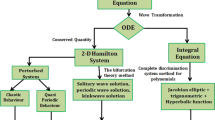Abstract
We develop some computer-assisted techniques for the analysis of stationary solutions of dissipative partial differential equations, of their stability, and of their bifurcation diagrams. As a case study, these methods are applied to the Kuramoto–Sivashinski equation. This equation has been investigated extensively, and its bifurcation diagram is well known from a numerical point of view. Here, we rigorously describe the full graph of solutions branching off the trivial branch, complete with all secondary bifurcations, for parameter values between 0 and 80. We also determine the dimension of the unstable manifold for the flow at some stationary solution in each branch.
Similar content being viewed by others
References
Kuramoto Y., Tsuzuki T.: Persistent propagation of concentration waves in dissipative media far from thermal equilibrium. Progr. Theor. Phys. 55, 365–369 (1976)
Sivashinsky G.I.: Nonlinear analysis of hydrodynamic instability in laminal flames— I. Derivation of basic equations. Acta Astr. 4, 1177–1206 (1977)
Kevrekidis J.G., Nicolaenko B., Scovel J.C.: Back in the saddle again: a computer assisted study of the Kuramoto–Sivashinsky equation. SIAM J. Appl. Math. 50, 760–790 (1990)
Jolly M.S., Kevrekidis J.G., Titi E.S.: Approximate inertial manifolds for the Kuramoto–Sivashinsky equation: analysis and computations. Physica D 44, 38–60 (1990)
Ilyashenko Y.S.: Global analysis of the phase portrait for the Kuramoto–Sivashinski equation. J. Dyn. Differ. Equ. 4, 585–615 (1992)
Collet P., Eckmann J.-P., Epstein H., Stubbe J.: A global attracting set for the Kuramoto-Sivashinsky equation. Commun. Math. Phys. 152, 203–214 (1993)
Grujić Z.: Spatial analyticity on the global attractor for the Kuramoto–Sivashinsky equation. J. Dyn. Differ. Equ. 12, 217–228 (2000)
Zgliczyński P., Mischaikow K.: Rigorous numerics for partial differential equations: the Kuramoto–Sivashinsky equation. Found. Comp. Math. 1, 255–288 (2001)
Zgliczyński P., Mischaikow K.: Towards a rigorous steady states bifurcation diagram for the Kuramoto–Sivashinsky equation—a computer assisted rigorous approach. Preprint, available at http://www.ii.uj.edu.pl/~zgliczyn/papers/ks/bifks.pd, 2003
Arioli G., Koch H., Terracini S.: Two novel methods and multi-mode periodic solutions for the Fermi-Pasta-Ulam model. Comm. Math. Phys. 255, 1–19 (2005)
Pazy A.: Semigroups of Linear Operators and Applications to Partial Differential Equations. Springer-Verlag, New York (1983)
Bates, P.W., Lu, K., Zeng, C.: Existence and persistence of invariant manifolds for semiflows in Banach space. Mem. Amer. Math. Soc. 135(645) (1998)
de la Llave R.: A smooth center manifold theorem which applies to some ill-posed partial differential equations with unbounded nonlinearities. J. Dyn. Diff. Eq. 21, 371–415 (2009)
Dunford N., Schwartz J.T.: Linear Operators. Part I: General Theory. Wiley- Interscience, New Edition (1988)
The GNU NYU Ada 9X Translator. Available at ftp://cs.nyu.edu/pub/gnat and many other places
Author information
Authors and Affiliations
Corresponding author
Additional information
Communicated by G. Friesecke
This work was supported in part by MIUR project “Metodi variazionali ed Equazioni Differenziali Non Lineari”.
This work was supported in part by the National Science Foundation under Grants No. DMS-0088935 and DMS-0322962.
Electronic Supplementary Material
The Below is the Electronic Supplementary Material.
Rights and permissions
About this article
Cite this article
Arioli, G., Koch, H. Computer-Assisted Methods for the Study of Stationary Solutions in Dissipative Systems, Applied to the Kuramoto–Sivashinski Equation. Arch Rational Mech Anal 197, 1033–1051 (2010). https://doi.org/10.1007/s00205-010-0309-7
Received:
Accepted:
Published:
Issue Date:
DOI: https://doi.org/10.1007/s00205-010-0309-7



